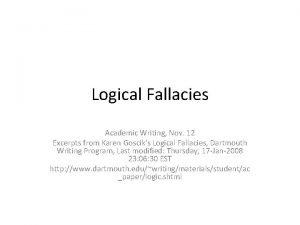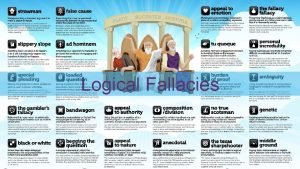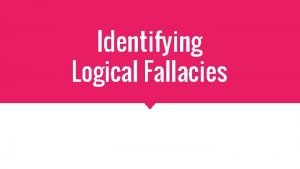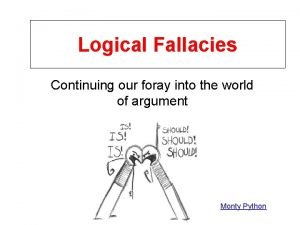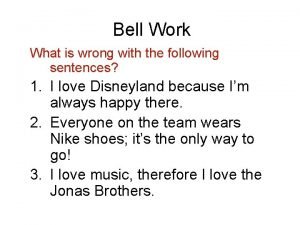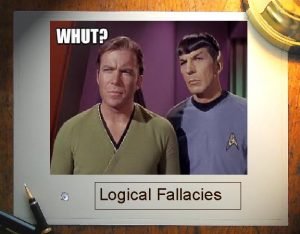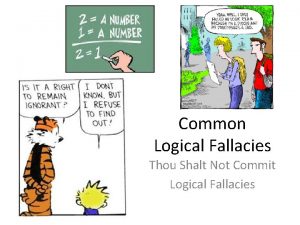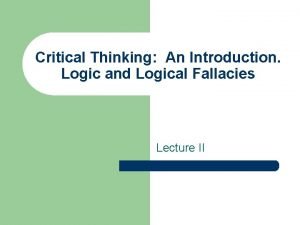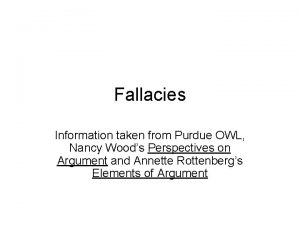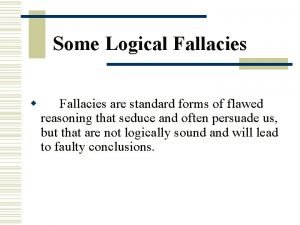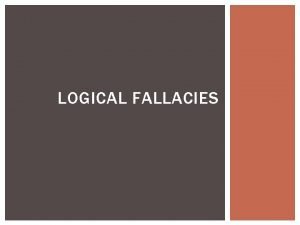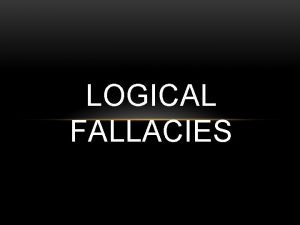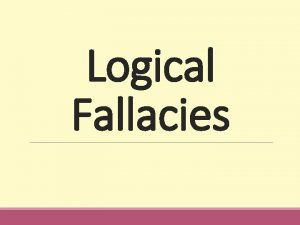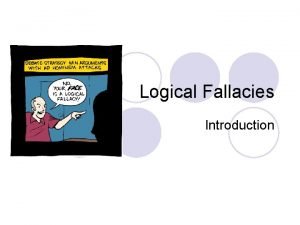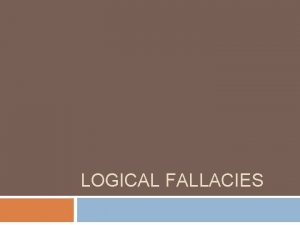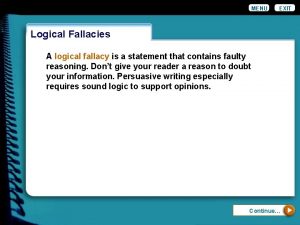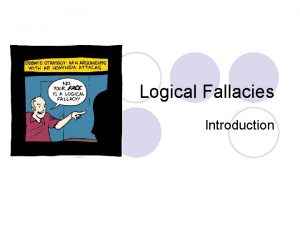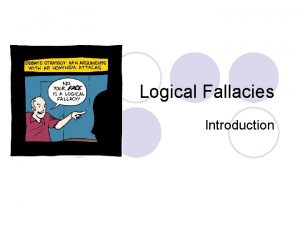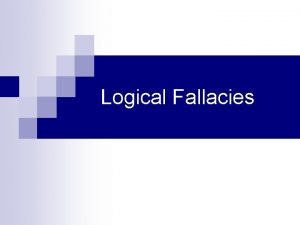Logical Fallacies What is a logical fallacy A
















- Slides: 16

Logical Fallacies

What is a logical fallacy? A logical fallacy is faulty reasoning or an error in logic (logos). Sometimes an argument appears to make sense but isn’t valid because it is based on a fallacy.

Types of logical fallacies v Circular v Either/or logic fallacy v Oversimplification v Overgeneralization v Stereotyping v Ad hominem/attacking the person

Types of fallacies (cont. ) v Evading v Non the issue sequitur v False v Hasty cause analogy generalization

1. Circular logic Supporting a statement by simply repeating it in different words https: //www. youtube. com/watch? v=j. M 3 a. CHIk_js

2. Either/or fallacy A statement that suggests that there are only two choices available in a situation that really offers more than two options https: //www. youtube. com/watch? v=XYpjb. Kj 3 eo 4

3. Oversimplification An explanation of a complex situation or problem as if it were much more simple than it is https: //www. youtube. com/watch? v=i. FXgu. Sl. V 78 Y

4. Overgeneralization A generalization that is too broad. You can often recognize the use of words like all, everyone, every time, anything, no one, and none. https: //www. youtube. com/watch? v=2 wtb. Rlf. M 0 PE

5. Stereotyping A dangerous type of overgeneralization. Stereotypes are broad statements about people on the basis of their gender, ethnicity, race, or political, social, professional, or religious group. https: //www. youtube. com/watch? v=ASDzcvyatgw

6. Ad hominem/attacking the person An attempt to discredit an idea by attacking the person or group associated with it. Candidates often engage in name-calling during political campaigns. https: //www. youtube. com/watch? v=Q 5 ktq 5 Cccac

7. Evading the Issue Refuting an objection with arguments and evidence that do not address its central point. https: //www. youtube. com/watch? v=YKWhcw-h. HIw

8. Non Sequitur A conclusion that does not follow logically from the “proof” offered to support it. A non sequitur is sometimes used to win an argument by diverting the reader’s attention to proof that cannot be challenged. https: //www. youtube. com/watch? v=VRZk 62 QNOs. M

9. False cause The mistake of assuming that because one event occurred after another event in time, the first event caused the second one to occur. https: //www. youtube. com/watch? v=q. MP 4 OXo. OBt. U

10. False analogy A comparison that does not hold up because of a critical difference between the two subjects. https: //www. youtube. com/watch? v=Ppb. L-wyy 678

11. Hasty generalization A conclusion drawn from too little evidence or from evidence that is biased. https: //www. youtube. com/watch? v=Yi. VJld. SU 7 Fk&list=PLGvvjs. Vt 2 f. PQorc. Smv HYj-UJf. EEhd. Zd_e&index=9

Activity: With a partner or group create your own fallacy from one of the logical fallacies you have just learned. You will draw a card randomly from the teacher with the name of the fallacy on it. Create the scenario with enough detail in order for the rest of the class to guess what it is. Keep your assignment a secret from the rest of the class. Be ready to present your logical fallacy to the class in the form of a video. All of the videos will be uploaded into one folder. 1. Circular logic 2. Either/or Fallacy 3. Oversimplification 4. Overgeneralization 5. Stereotyping 6. Ad hominem/attacking the person 7. Evading the issue 8. Non sequitur 9. False cause 10. False analogy 11. Hasty Generalization
 Appeal to vanity fallacy
Appeal to vanity fallacy Logical fallacies detector
Logical fallacies detector Name calling propaganda in animal farm
Name calling propaganda in animal farm Logical fallacies in academic writing
Logical fallacies in academic writing Strawman argument
Strawman argument Examples of dogmatism fallacy
Examples of dogmatism fallacy Logical fallacies referee
Logical fallacies referee Argument from ignorance
Argument from ignorance Logical fallacies bell ringer journal
Logical fallacies bell ringer journal Fallacies in the media
Fallacies in the media Thou shalt not commit logical fallacies image
Thou shalt not commit logical fallacies image Logical fallacies
Logical fallacies Owl logical fallacies
Owl logical fallacies Appeal to vanity fallacy
Appeal to vanity fallacy Nonfiction test
Nonfiction test Fallacies in the crucible act 3
Fallacies in the crucible act 3 Appeal to pity
Appeal to pity



